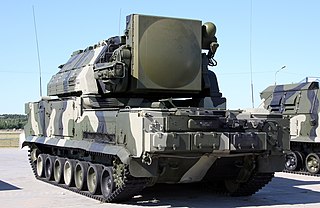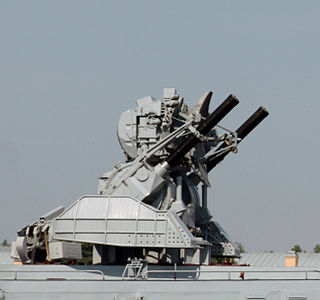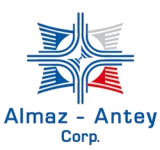
The S-300 is a series of long-range surface-to-air missile systems developed by the former Soviet Union. It was produced by NPO Almaz for the Soviet Air Defence Forces to defend against air raids and cruise missiles.

The NPO Almaz S-200 Angara/Vega/Dubna, NATO reporting name SA-5 Gammon, is a long-range, high-altitude surface-to-air missile (SAM) system developed by the Soviet Union in the 1960s to defend large areas from high-altitude bombers or other targets. In Soviet service, these systems were deployed primarily on the battalion level, with six launchers and a fire control radar.

The Buk is a family of self-propelled, medium-range surface-to-air missile systems developed by the Soviet Union and its successor state, the Russian Federation, and designed to counter cruise missiles, smart bombs and rotary-wing aircraft, and unmanned aerial vehicles. In the Russian A2AD network, Buk is located between the S-200/300/400 systems above and the point defense Tor and Pantsir type systems below.

The Tor is an all-weather, low-to medium-altitude, short-range surface-to-air missile system designed for destroying airplanes, helicopters, cruise missiles, unmanned aerial vehicles and short-range ballistic threats (anti-munitions). Originally developed by the Soviet Union under the GRAU designation 9K330 Tor, the system is commonly known by its NATO reporting name, SA-15 "Gauntlet". A navalized variant was developed under the name 3K95 "Kinzhal", also known as the SA-N-9 "Gauntlet". Tor was designed to shoot down guided weapons like the AGM-86 ALCM and BGM-34 day and night, in bad weather and jamming situations. Tor can detect targets while on the move. The vehicle must stop intermittently when firing, although trials have been conducted with the goal of eliminating this restriction.

The S-400 Triumf, previously known as the S-300 PMU-3, is a mobile surface-to-air missile (SAM) system developed in the 1990s by Russia's NPO Almaz as an upgrade to the S-300 family of missiles. The S-400 was approved for service on 28 April 2007 and the first battalion of the systems assumed combat duty on 6 August 2007. The system is complemented by its successor, the S-500.

The P-800 Oniks, marketed in export as the Yakhont, is a Soviet / Russian supersonic anti-ship cruise missile developed by NPO Mashinostroyeniya as a ramjet version of P-80 Zubr. Its GRAU designation is 3M55, the air launched Kh-61 variant was planned but never built. The missile has the NATO codename SS-N-26 "Strobile". Development commenced in 1983, and in the 1990s the anti-ship missile was tested on the Project 1234.7 ship. In 2002 the missile passed the whole range of trials and was commissioned. It is reportedly a replacement for the P-270 Moskit, and possibly also of the P-700 Granit.

The S-300VM "Antey-2500" is a Russian anti-ballistic missile system. The system is designed to target short- and medium-range ballistic missiles, aeroballistic missiles, cruise missiles, fixed-wing aircraft, loitering ECM platforms, and precision-guided munitions.

The Kortik close-in weapon system (CIWS) is a modern naval air defence gun-missile system deployed by the Russian Navy. Its export version is known as Kashtan, with the NATO designation CADS-N-1 Kashtan.

The Pantsir missile system is a family of self-propelled, medium-range surface-to-air missile and anti-aircraft artillery systems. Three types of vehicles make up one system: a missile launcher, a radar truck and a command post. Starting with the Pantsir-S1 as the first version, it is produced by KBP Instrument Design Bureau of Tula, Russia, and is the successor to the Tunguska M1.

NPO Novator is a Russian company that designs long-range anti-aircraft missiles. It was established in 1947 as OKB-8 in Sverdlovsk, became independent in 1991, and then became part of the Almaz-Antey conglomerate. It is perhaps best known for designing the 9M82 and 9M83 missiles of the S-300V SAM system.

The S-500 Prometheus, also known as 55R6M "Triumfator-M", is a Russian surface-to-air missile/anti-ballistic missile system supplementing the S-400 and the A-235 ABM missile system. The S-500 was developed by the Almaz-Antey Air Defence Concern. Initially planned to be in production by 2014, the first unit entered service in 2021 with the 15th Aerospace Army. Russia claims that the S-500 is capable of intercepting all types of modern hypersonic weapons; and has claimed to have successfully tested such capability. Russia is reportedly planning to deploy the S-500 alongside the planned S-550 missile system as part of its air defense network.

JSC Concern VKO "Almaz-Antey" is a Russian state-owned company in the arms industry, a result of a merger of Antey Corporation and NPO Almaz, unifying some of the national military enterprises, in particular, the developers of anti-aircraft defence and cruise missile systems. The organisation is headquartered in Moscow and is the world's eighth-largest defence contractor measured by 2017 defence revenues. In 2017, Almaz-Antey had arms sales of $9.125 billion.
Open joint-stock company (JSC) NMZ or Nizhny Novgorod Machine-building Plant is a Russian artillery factory in the Sormovo district of Gorky. It included the TsAKB artillery design bureau led by Vasiliy Grabin.

JSC NPO Almaz named after A.A. Raspletin is a Soviet/Russian military R&D enterprise founded in 1947. It is the core of the Almaz-Antey holding. Headquarters – Moscow, Leningradsky av., 80.

MKB "Fakel", also known as Grushin Machine-building Design Bureau, is a Russian government-owned aerospace defense corporation located in Khimki, Moscow Oblast, Russia.

Hermes is a family of modularly designed guided missiles developed in Russia by the KBP Instrument Design Bureau.

The KM-SAM which is also known as the Cheolmae-2 is a South Korean medium range surface-to-air missile (SAM) system that was developed by the Agency for Defense Development (ADD) with technical support from Almaz-Antey and Fakel, based on technology from the 9M96 missile used on S-350E and S-400 missile systems.
42S6 Morfey or Morfei with missile 9M338K or RZV-MD based and derived from the Tor-M2, is a short range air defense system currently being developed for the Russian Armed Forces. It is a mobile system with a range of 5 km (3 mi). Development has been ongoing since 2007 and it is supposed to be introduced in 2015. It is reported to feature an omnidirectional cupola-type radar with Active electronically scanned array. It is being developed by Almaz-Antey.
System A-235 PL-19 Nudol is a Russian hypersonic anti-ballistic missile and anti-satellite weapon system in development. It is designed to deflect a nuclear attack on Moscow and other regions within European Russia. The main developer of the system is JSC Concern VKO Almaz-Antey. The new system should replace the current one — A-135. The two main differences will be that the A-235 will use conventional warheads and it will be road-mobile.

The 9M337 Sosna-R (Pine) (SA-X-25) is a Russian radar and laser-guided supersonic two-stage missile. It is used in Sosna-R short range air defense missile system designed to protect military units from air attacks in all types of combat situations, including during march.




















